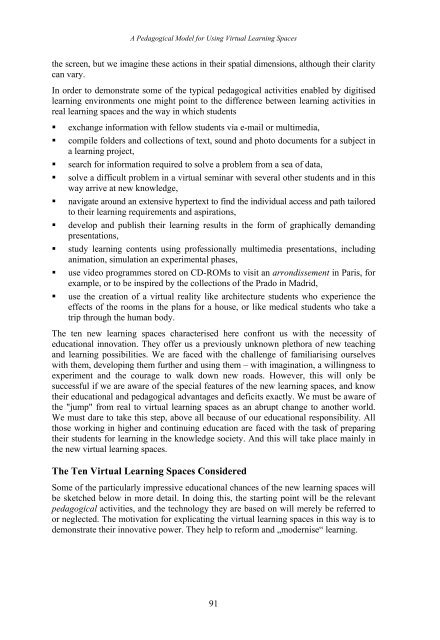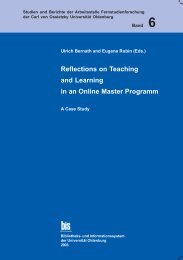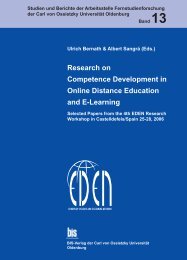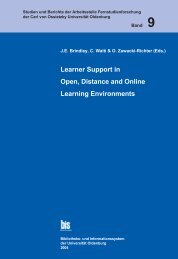Distance Education in Transition - Master of Distance Education ...
Distance Education in Transition - Master of Distance Education ...
Distance Education in Transition - Master of Distance Education ...
Create successful ePaper yourself
Turn your PDF publications into a flip-book with our unique Google optimized e-Paper software.
A Pedagogical Model for Us<strong>in</strong>g Virtual Learn<strong>in</strong>g Spaces<br />
the screen, but we imag<strong>in</strong>e these actions <strong>in</strong> their spatial dimensions, although their clarity<br />
can vary.<br />
In order to demonstrate some <strong>of</strong> the typical pedagogical activities enabled by digitised<br />
learn<strong>in</strong>g environments one might po<strong>in</strong>t to the difference between learn<strong>in</strong>g activities <strong>in</strong><br />
real learn<strong>in</strong>g spaces and the way <strong>in</strong> which students<br />
� exchange <strong>in</strong>formation with fellow students via e-mail or multimedia,<br />
� compile folders and collections <strong>of</strong> text, sound and photo documents for a subject <strong>in</strong><br />
a learn<strong>in</strong>g project,<br />
� search for <strong>in</strong>formation required to solve a problem from a sea <strong>of</strong> data,<br />
� solve a difficult problem <strong>in</strong> a virtual sem<strong>in</strong>ar with several other students and <strong>in</strong> this<br />
way arrive at new knowledge,<br />
� navigate around an extensive hypertext to f<strong>in</strong>d the <strong>in</strong>dividual access and path tailored<br />
to their learn<strong>in</strong>g requirements and aspirations,<br />
� develop and publish their learn<strong>in</strong>g results <strong>in</strong> the form <strong>of</strong> graphically demand<strong>in</strong>g<br />
presentations,<br />
� study learn<strong>in</strong>g contents us<strong>in</strong>g pr<strong>of</strong>essionally multimedia presentations, <strong>in</strong>clud<strong>in</strong>g<br />
animation, simulation an experimental phases,<br />
� use video programmes stored on CD-ROMs to visit an arrondissement <strong>in</strong> Paris, for<br />
example, or to be <strong>in</strong>spired by the collections <strong>of</strong> the Prado <strong>in</strong> Madrid,<br />
� use the creation <strong>of</strong> a virtual reality like architecture students who experience the<br />
effects <strong>of</strong> the rooms <strong>in</strong> the plans for a house, or like medical students who take a<br />
trip through the human body.<br />
The ten new learn<strong>in</strong>g spaces characterised here confront us with the necessity <strong>of</strong><br />
educational <strong>in</strong>novation. They <strong>of</strong>fer us a previously unknown plethora <strong>of</strong> new teach<strong>in</strong>g<br />
and learn<strong>in</strong>g possibilities. We are faced with the challenge <strong>of</strong> familiaris<strong>in</strong>g ourselves<br />
with them, develop<strong>in</strong>g them further and us<strong>in</strong>g them – with imag<strong>in</strong>ation, a will<strong>in</strong>gness to<br />
experiment and the courage to walk down new roads. However, this will only be<br />
successful if we are aware <strong>of</strong> the special features <strong>of</strong> the new learn<strong>in</strong>g spaces, and know<br />
their educational and pedagogical advantages and deficits exactly. We must be aware <strong>of</strong><br />
the "jump" from real to virtual learn<strong>in</strong>g spaces as an abrupt change to another world.<br />
We must dare to take this step, above all because <strong>of</strong> our educational responsibility. All<br />
those work<strong>in</strong>g <strong>in</strong> higher and cont<strong>in</strong>u<strong>in</strong>g education are faced with the task <strong>of</strong> prepar<strong>in</strong>g<br />
their students for learn<strong>in</strong>g <strong>in</strong> the knowledge society. And this will take place ma<strong>in</strong>ly <strong>in</strong><br />
the new virtual learn<strong>in</strong>g spaces.<br />
The Ten Virtual Learn<strong>in</strong>g Spaces Considered<br />
Some <strong>of</strong> the particularly impressive educational chances <strong>of</strong> the new learn<strong>in</strong>g spaces will<br />
be sketched below <strong>in</strong> more detail. In do<strong>in</strong>g this, the start<strong>in</strong>g po<strong>in</strong>t will be the relevant<br />
pedagogical activities, and the technology they are based on will merely be referred to<br />
or neglected. The motivation for explicat<strong>in</strong>g the virtual learn<strong>in</strong>g spaces <strong>in</strong> this way is to<br />
demonstrate their <strong>in</strong>novative power. They help to reform and „modernise“ learn<strong>in</strong>g.<br />
91





